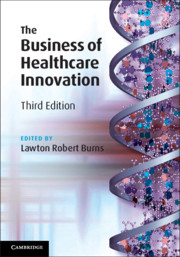Book contents
- The Business of Healthcare Innovation
- Reviews
- Other Cambridge Volumes
- The Business of Healthcare Innovation
- Copyright page
- Dedication
- Contents
- Figures
- Contributors
- Preface
- Acknowledgments
- 1 Product Suppliers in the Healthcare Value Chain
- 2 The Pharmaceutical Sector
- 3 The Biotechnology Sector: Therapeutics
- 4 New Venture Creation in Biotechnology
- 5 The Medical Device Sector
- 6 Financing Medtech Innovation
- 7 The Healthcare Information Technology Sector
- Index
5 - The Medical Device Sector
Published online by Cambridge University Press: 24 February 2020
- The Business of Healthcare Innovation
- Reviews
- Other Cambridge Volumes
- The Business of Healthcare Innovation
- Copyright page
- Dedication
- Contents
- Figures
- Contributors
- Preface
- Acknowledgments
- 1 Product Suppliers in the Healthcare Value Chain
- 2 The Pharmaceutical Sector
- 3 The Biotechnology Sector: Therapeutics
- 4 New Venture Creation in Biotechnology
- 5 The Medical Device Sector
- 6 Financing Medtech Innovation
- 7 The Healthcare Information Technology Sector
- Index
Summary
Medical devices and medical technology, with worldwide revenues of roughly $330 billion, comprise an important segment within healthcare. This broad set of products, ranging from extraordinarily complex implantable defibrillators to metal mesh stents to hip and knee implants, have truly advanced the practice of medicine and represent life-saving therapies to patients in need. Growth, in recent years, while slower than that of the 1990s when several entirely new therapeutic categories emerged, continues at a good pace. The industry is increasingly dominated by large companies such as Medtronic, Abbott, Johnson & Johnson, and Stryker which offer a broad mix of technologies in multiple anatomies and diseases. In as much as structural developments, including reimbursement and the containment of healthcare costs, they have made it more difficult for single product/single anatomy companies to flourish. Those that provide truly innovative products that are treatment-altering can succeed and remain independent. Indeed, there exist several examples – in areas such as diabetes, heart failure, and neurological diseases. Furthermore, the industry remains highly profitable – companies on average enjoy operating margins in the mid-twenties, considerably higher than nearly every other industry. We anticipate continued growth for the sector as devices and technology play an expanded role in healthcare. Of the US $3.6 trillion healthcare spend, medical technology represents less than 5 percent on a revenue basis.
Keywords
- Type
- Chapter
- Information
- The Business of Healthcare Innovation , pp. 321 - 397Publisher: Cambridge University PressPrint publication year: 2020
- 2
- Cited by



